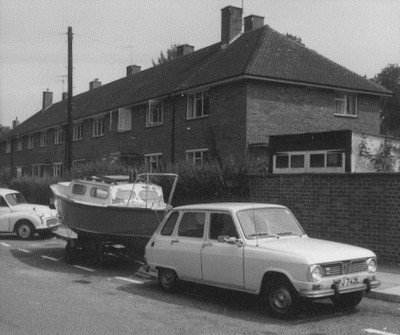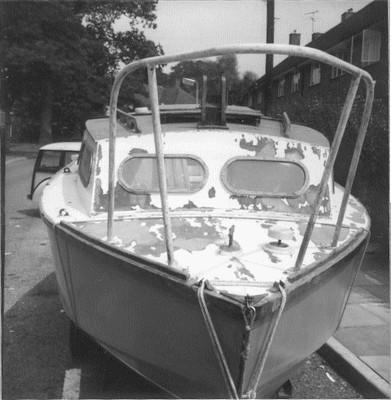Chapter 5 Our own boat
We decided it would be good to have our own boat - oh, all right, I decided, Linda acquiesced - and I started to look around. Everything seemed to be too expensive. Of course, I didn't have any idea where to look; there were no "Buy a Boat for less than £2,000" magazines then. But one Saturday morning in early summer, I saw a small ad in the Crawley and Horley Advertiser or some such title (yes, we were living in Crawley by then - well, someone has to). It said "17ft Sailing Cruiser for sale with road trailer; needs some attention. £500 ono". I rang, arranged to see it, thought it was basically OK, offered £400 and settled on £425. I put a towing hitch (cost £12) on to our Renault 6 (850cc, 42bhp, what a charger!) and dragged it back to Crawley where Linda took these photos.


In the photos you can see the Renault 6, our house at the time (the one nearest to the camera in the first photo) and my Morris Minor Traveller behind the boat (the Renault was Linda's car).
Then it was off to Haywards Heath where L's parents had kindly agreed to let me keep it in their garage while I renovated it. Looking at these pictures now I wonder if I paid too much for it - you could probably pick up a plywood boat in similar condition now for about the same money, 29 years on. But then there just wasn't the choice; the bottom line in the mid-'70s was about £1,000 for a small sailing cruiser in good condition, ready to sail - and that figure hasn't really changed much in the intervening years.
The boat was called “Rambler”. It was a Lysander class 17ft marine ply two berth sailing cruiser with bilge keels. Designed by one Percy Blandford in the early sixties (he also designed many other small boats and wrote books about boat building and maintenance, as well as others about traditional handicrafts). The deck and cabin sides had been painted white, the hull and coachroof had been blue, but as you can see from the photos, most of the paint had peeled off. It was all basically sound apart from a patch of rot in the top starboard corner of the transom. That summer I worked hard, removing and renovating all the fittings, stripping the whole hull back to bare wood, and repairing the rotten bit of transom - I had to replace the corner of the deck, corner of the transom and the corner of the starboard topside as well as part of the framing beneath.
“That summer” was the famous heat-wave summer of 1976. Linda’s parents lived in a bungalow in a dead end unmade road in a steep little valley in Haywards Heath. It was very, very hot. What little wind there was never seemed to get as far as the bungalow. On the plus side paint took about 20 minutes to be touch dry and glues and resins went off in record time. I developed a Heineken addiction. We had the usual six week teacher holidays (the only thing that kept - keeps - many people in teaching) and I spent five of them working on the boat - seven days most weeks, driving the 15 miles to H. Heath in the early-ish morning and back again in time for dinner in the evening. Linda came with me sometimes, but she ended up talking to her mother all day long so soon gave that up. I don’t think it rained once. I was very brown, but much of the time I didn’t look it because I was covered with dust from sanding and sawing.
In the middle of the holiday we decided to go to Scotland with our tent and dog for a break. The boat was getting on quite well and we hadn’t been that far north before. A friend had recommended Applecross about three quarters of the way up the west coast, so we headed for there in our trusty Renault 6. On the way up we went through a sort of weather portal about thirty miles north of Glasgow. The temperature dropped considerably, the sunshine turned into rain and mist, and we donned sweaters and anoraks. We lasted five days before we came home. On one occasion we sat in the tent at lunchtime, listening to the rain, the dog wrapped in Linda’s sleeping bag because she was shivering, and heard on the radio that old people were dropping dead on the streets of London from heatstroke. So when people talk about the wonderful heatwave summer of 1976 remember that it wasn’t that hot everywhere. We drove south and, as we passed Glasgow the sun came out and we took off our sweaters again; it was like driving through a door into summer.
Eventually the boat was finished enough to be moved back to our house in Crawley (the rationale for keeping it at H.Heath was that it could sit in the garage when it rained and overnight - hardly necessary, as it happened). The exterior was done and looking good and I could finish the inside over the autumn and winter. I had to take out our gateposts and a couple of privet bushes to get the boat into our garden, but there it sat for the next six months, slowly being finished to be ready for the next Spring. The School workshops came in handy for all sorts of jobs that winter, from stripping the mast and spars to making a new carved name board for the transom. I decided to rename the boat “Fram”, partly after Fritjof Nansen’s Arctic exploration vessel (“fram” means onward or forward in Norwegian) and partly after Uncle Jim’s houseboat in “Swallows and Amazons”. My Lysander probably still holds the record for the smallest boat ever to be called “Fram”.
|

